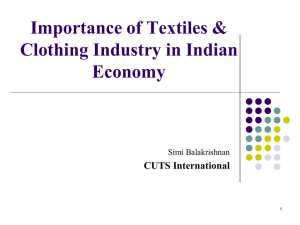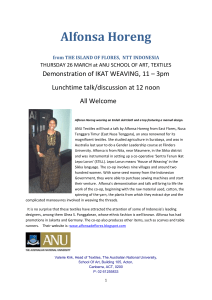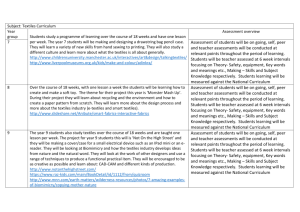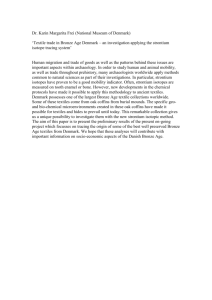November 2008
advertisement
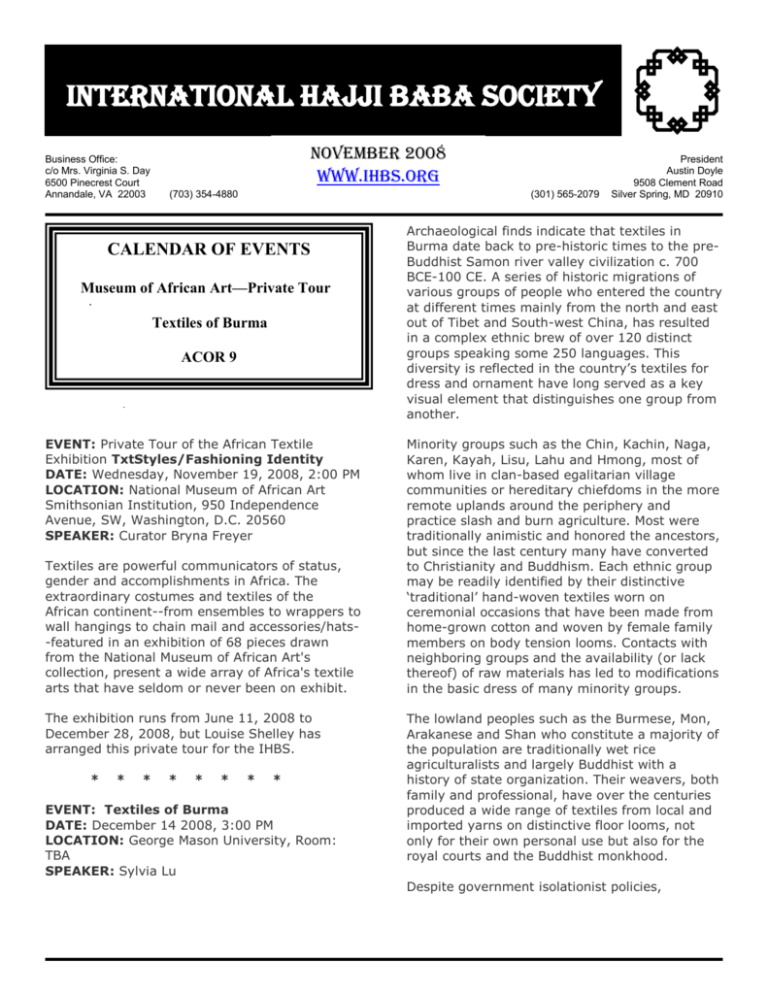
INTERNATIONAL HAJJI BABA SOCIETY Business Office: c/o Mrs. Virginia S. Day 6500 Pinecrest Court Annandale, VA 22003 November 2008 www.ihbs.org (703) 354-4880 (301) 565-2079 CALENDAR OF EVENTS Museum of African Art—Private Tour Textiles of Burma ACOR 9 EVENT: Private Tour of the African Textile Exhibition TxtStyles/Fashioning Identity DATE: Wednesday, November 19, 2008, 2:00 PM LOCATION: National Museum of African Art Smithsonian Institution, 950 Independence Avenue, SW, Washington, D.C. 20560 SPEAKER: Curator Bryna Freyer Textiles are powerful communicators of status, gender and accomplishments in Africa. The extraordinary costumes and textiles of the African continent--from ensembles to wrappers to wall hangings to chain mail and accessories/hats-featured in an exhibition of 68 pieces drawn from the National Museum of African Art's collection, present a wide array of Africa's textile arts that have seldom or never been on exhibit. The exhibition runs from June 11, 2008 to December 28, 2008, but Louise Shelley has arranged this private tour for the IHBS. * * * * * * * * EVENT: Textiles of Burma DATE: December 14 2008, 3:00 PM LOCATION: George Mason University, Room: TBA SPEAKER: Sylvia Lu President Austin Doyle 9508 Clement Road Silver Spring, MD 20910 Archaeological finds indicate that textiles in Burma date back to pre-historic times to the preBuddhist Samon river valley civilization c. 700 BCE-100 CE. A series of historic migrations of various groups of people who entered the country at different times mainly from the north and east out of Tibet and South-west China, has resulted in a complex ethnic brew of over 120 distinct groups speaking some 250 languages. This diversity is reflected in the country’s textiles for dress and ornament have long served as a key visual element that distinguishes one group from another. Minority groups such as the Chin, Kachin, Naga, Karen, Kayah, Lisu, Lahu and Hmong, most of whom live in clan-based egalitarian village communities or hereditary chiefdoms in the more remote uplands around the periphery and practice slash and burn agriculture. Most were traditionally animistic and honored the ancestors, but since the last century many have converted to Christianity and Buddhism. Each ethnic group may be readily identified by their distinctive ‘traditional’ hand-woven textiles worn on ceremonial occasions that have been made from home-grown cotton and woven by female family members on body tension looms. Contacts with neighboring groups and the availability (or lack thereof) of raw materials has led to modifications in the basic dress of many minority groups. The lowland peoples such as the Burmese, Mon, Arakanese and Shan who constitute a majority of the population are traditionally wet rice agriculturalists and largely Buddhist with a history of state organization. Their weavers, both family and professional, have over the centuries produced a wide range of textiles from local and imported yarns on distinctive floor looms, not only for their own personal use but also for the royal courts and the Buddhist monkhood. Despite government isolationist policies, 2 urbanization, globalization and textile technological innovations have also brought about changes to what is being worn and how textiles are made and used in Burma. For a map of the campus, see: http://www.gmu.edu/departments/infoservices/rl ingtonMap07.pdf FREE STREET PARKING IS AVAILABLE. SYLVIA FRASER-LU ACOR 9 A New Zealander by birth, Sylvia Fraser-Lu after graduating from Otago University, spent many years as an educator in a variety of teaching and administrative positions in East and Southeast Asia. Her growing interest in Asian arts and crafts led her to begin writing articles for Arts of Asia and reviews for Oriental Art in the late seventiesearly eighties. Books for Oxford Press soon followed such as Indonesian Batik: Patterns Processes and Places (1986), Handwoven Textiles of South-East Asia (1988), and Silverware of South-East Asia (1989). She also served as series advisor to Oxford University's Images of Asia Upon her husband's retirement to the United States she served as Program Assistant at the Asia Society's Washington Center. As the ACOR and rug society liaison, I want to tell everyone that the next ACOR conference (ACOR 9) will be held at the Millenium Hotel in St. Louis, Missouri, from April 30 – May 3, 2009. There will be exhibitions of Weavings from the Americas, Middle Amu Darya, Southwest Persia, the Belouch, collections from the Midwest as well as Central Asian costumes. These will all be first class exhibitions. In addition, there will be workshops on restoration, small sessions where collectors show selections and the usual wide program of illustrated talks. More information can be found at the ACOR site: In recent years she has turned her attention to Burma with publications such as Burmese Lacquerware (Orchid Press, 1985 and 2000, Bangkok) and Burmese Crafts: Past and Present (Oxford Press 1993, Singapore, and Splendour in Wood: The Buddhist Monasteries of Burma, Orchid Press, 2001. She continues to teach and lecture on Chinese and Southeast Asian art and is currently working on a book on Burman textiles. DIRECTIONS TO GEORGE MASON UNIVERSITY ARLINGTON CAMPUS (3301/3401 Fairfax Dr., Arlington): From Washington, DC, cross over the Key or Roosevelt Bridge; follow signs to the George Washington Parkway. Once on the parkway, exit at Spout Run (left exit). Cross over Route 29 (Lee Highway). Spout Run is now Kirkwood Road. Cross over Washington Boulevard. The Arlington Campus is on the right, at Fairfax Drive. By Metro Take the Orange Line to the Virginia Square/GMU station. Take the escalator to the street level, and turn to face Fairfax Drive. Across the street and to the right, you will see the FDIC building. The Arlington Campus is next door. http://www.acor-rugs.org/next-conference.html The informative brochure can be downloaded from: https://acor9.theregistrationsystem.com/page_d ownload/document/1011/ACOR_9_Informative_Fl yer.pdf And the registration form can be downloaded from: https://acor9.theregistrationsystem.com/page_d ownload/document/1010/ACOR_9_Registration_F orm.pdf Wendel Swan * * * * * * * Dear friends and IHBS members, For the ACOR in St. Louis in April, once again I have been asked to chair a Mystery Rug panel, for which I would like to ask your help in making the session as interesting as possible. 2 Page 3 I am searching for about 15 “mystery rugs” for the panel to examine and discuss. We are not limited to carpets and rugs. We can discuss any kind of textile from any region or culture. The “mystery” could be any one or more of the following: 1. 2. 3. 4. 5. 6. 7. 8. Where is it from? Who made it? What is the age? Is it a fake or a reproduction or the real thing? What is the function of the object? Why does the object have its peculiar format? Why is this one considerably different from others from the same people or area? If the piece is a fragment, what did the whole object look like? Clearly, there are other possibilities. If you own or have seen a rug, bag, textile or other weaving that you have always wondered about or if you can think of one about which rug collectors generally would have unanswered questions, I’d love to hear about what you have or have seen. Of course, if the object is beautiful or particularly old, that would enhance the discussion. We hope not to answer questions like: “Why would anyone buy such an ugly rug?” I would like to have images of all the “mystery” candidates well before April. Please send images or suggestions to me at: wdswan@erols.com The session is tentatively set for Sunday from 11 a.m. until noon. The panel needs to examine all the objects in the morning prior to the session. Thanks for your help. Wendel Swan 3 Page


